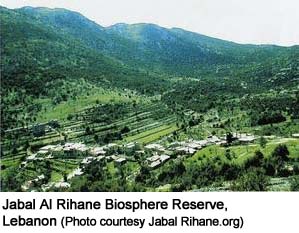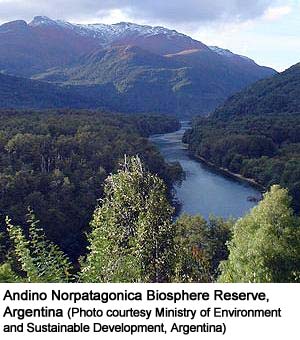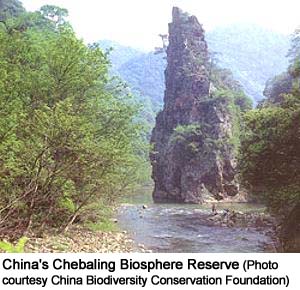The first biosphere reserves set aside by El Salvador, Qatar, and the United Arab Emirates are among 23 new reserve sites in 18 countries today accepted by UNESCO into its Man and the Biosphere global network. The reserves are not strictly protected areas but are intended as vehicles for sharing knowledge, research and monitoring, education and training, and participatory decision-making as well as conservation.
Representatives of the International Co-ordinating Council of UNESCO's Man and the Biosphere Program made the additions during a three day meeting at the agency's headquarters in Paris. The council consists of 34 member states elected by UNESCO's biennial general conference.
Changes to two existing biosphere reserves also have been approved. The reserves of Frontenac in Canada and the Great Volzhsko-Laùslu in the Russian Federation were extended.
Meanwhile Germany withdrew the Bayerischer Wald biosphere reserve from the network because it no longer meets the UNESCO criteria. The network now extends to 529 sites in 105 countries.
In managing them, emphasis is placed on linkages between biodiversity conservation and socio-economic development. Opportunities are developed to combine scientific knowledge and governance to reduce biodiversity loss; improve livelihoods; and enhance social, economic and cultural conditions for environmental sustainability. Biosphere reserves also can serve as learning and experimentation sites.
The 23 new biosphere reserves are:
Cape Winelands, South Africa includes the world-renowned Cape Winelands viticultural landscape and part of the Cape Floral Kingdom with some of the most outstanding diversity, density and endemism of plants in the world. It constitutes an important part of the planned Fynbos Cluster Biosphere Reserve Network. More than 300,000 people live in an array of historic towns, hamlets and farmsteads of Cape Dutch architecture.
Noosa, Australia is considered as a "biodiversity museum" critical to maintaining biodiversity representation and quality in southeast Queensland. In order to conserve the natural and cultural resources of the site and use them in a sustainable way, Noosa communities endeavor to manage urban growth in a sustainable manner and develop sustainable tourism strategies in the buffer and transition zones.
Western Nghe An, Vietnam. Due to the mountainous terrain reaching an altitude of over 2,000 meters and its remote location, bordering Laos, the area has a high level of biodiversity ranging from lowland monsoonal evergreen forests to elfin cloud forest. This site could play an important role in developing the economy and raising the standard of living of ethnic groups such as the Thai, Dan Lai, Kho Mu, O Du, and H'Mong.
Marawah Biosphere Reserve, United Arab Emirates. This first biosphere reserve in the Emirates protects marine and costal ecosystems such as sea grass beds, coral reefs and mangroves. The world's second largest population of dugongs finds shelter and food here. The area is also of significance culturally and archeologically with more than 20 sites dating back to the 16th century on its various islands.
Jabal Al Rihane, Lebanon is a green island amidst bare lands of the semi-arid Bekaa valley to the east and the dry plains to the south. The site, whose name means "mountain of basil," shelters a number of eco-zones, peaks and basins, and stands of 500 year old oak trees.

Manicouagan Uapishka, Canada, lies between the Saint Laurent River in the South and the Manicouagan reservoir in the north. It is visible from outer space from where it has the shape of an eye. Numerous rivers cross the forests where mining of nickel, copper, silver, gold and graphite takes place. An in-depth participatory process led to a shared vision for sustainable development for the region. The site is also used as a platform for integrating activities across UNESCO's intergovernmental scientific programs. Baie-Comeau is the biggest city in the site with 22,613 inhabitants.
Fundy, Canada, is located on the New Brunswick side of the uppermost part of the bay. Aboriginal artifacts date back more than 6,000 years and some of the earliest colonial settlements in North America were established here. Towering cliffs fall to broad sweeping salt marshes at the head of the bay. The Fundy Biosphere Regional Network, a stakeholder group, has launched innovative practices for sustainable development.
Sierra de Alamos - Río Cuchujaqui, Mexico, encompasses fragile desert ecosystems of the Western Sierra Madres and the northwestern coastal plains, and includes low tropical deciduous forests and dense evergreen forests. The mountain range parallels the Pacific Ocean, and has many deep ravines. The Cuchujaqui River is inhabited by rare pumas, jaguars and ocelots. About 400 people live within the biosphere reserve.
Apaneca-Llamatepec, El Salvador. The Santa Ana, or Llamatepec, volcano is the largest volcano in El Salvador, 2,381 meters above sea level, and is the nucleus for neighboring "parasitic" volcanoes. This is a key ecosystem for filtering water that drains into aquifers, benefiting the entire country. The reserve shows potential to develop sustainable shade-grown coffee production enterprises through innovative participatory practices.
Xiriualtique Jiquitizco, El Salvador, translates to "place in the bay of stars." It is the largest extension of mangroves in El Salvador and includes some of the largest forest areas in the country. The people living in the reserve are working towards sustainable production, management of protected areas, risk management, and recovery of traditional ecological knowledge. Sustainable development in the area is based on tourism and the harvest of mangroves, coconuts, sugarcane, fish, and livestock.
Andino Norpatagonica, Argentina includes mountain ecosystems, temperate forests, pastures, and the sub Andean steppe. The area is the easternmost example of Argentine/Chilean temperate rainforests and is recognized by the World Resources Institute and WWF as a Global 200 Site. It is listed as a biodiversity hotspot by Conservation International. The neighboring populations benefit from adventure tourism activities such as sport fishing, skiing, and trekking.

Pereyra Iraola, Argentina, constitutes the last remaining natural habitats along the Rio de la Plata. It is the highest biodiversity and the largest green area in the Buenos Aires Province, home to 12 million people. The watersheds included in the Biosphere Reserve recharge the overexploited subterranean aquifers and provide clean drinking water to the densely populated areas surrounding the Reserve. The Reserve also protects Buenos Aires' cultural heritage such as traditional dances and handicrafts in leather and wool.
Bosques Templados Lluviosos de los Andes Australes, Chile includes critical high mountain ecosystems and water resources. The coastal temperate rainforests of Chile and Argentina represent 33 percent of this type of ecosystem in the world. The area is recognized by the World Resources Institute and WWF as a Global 200 Site, and as a hotspot by Conservation International. Local populations are engaged in ecotourism initiatives like trekking. The Biosphere Reserve is adjacent to Argentina's Andino Norpatagonica Biosphere Reserve and there is potential for a transboundary biosphere reserve between the two countries.
Agua y Paz, Costa Rica. Located in the San Juan River watershed, near the Caribbean Sea and the border with Nicaragua, its humid tropical lowland forests are inhabited by rare species like jaguar and manatee. Lakes and navigable rivers, wetlands and rafia palm bogs include the Caño Negro wetland, which is considered the nucleus of the Reserve and is also a Wetland of International Importance under the Ramsar Convention. This reserve assures ecological continuity between Costa Rica's Cordillera Volcánica Central Biosphere Reserve and Nicaragua's Indio Maiz Biosphere Reserve.
Podocarpus-El Condor, Ecuador along Ecuador's border with Peru conserves tropical forest ecosystems and water resources where the Amazon, the high Andes, and the Paramo converge. Ranging from 700 to 3,790 metres above sea level the reserve encompasses 48 distinct ecosystems and provides critical habitat for many endemic species. Because of recent scientific discoveries, it is one of the highest priority areas for scientific research in the Neotropics. The Podocarpus tree, for which the area is named, is native to the region's cloud forests. The El Condor mountain range shelters multiculturalism, ecological and mineral diversity.
And Atoll, Federated States of Micronesia. Spread over a seascape more than half the size of the United States, the 607 islands and surrounding reefs of the Federated States of Micronesia feature mangroves, more than 1,000 species of fish, 350 species of coral, and thousands of species of sponges. And Atoll is one of the last relatively intact seabird rookeries in the region and provides crucial nesting grounds for rare sea turtles. It has the only healthy population of giant clams and has aggregations of grey reef sharks and barracuda. And Atoll has great potential for ecotourism with diving and snorkelling. Sustainable development alternatives include the production of black peals, giant clams, sponges, and soft coral. Overfishing and hunting are the major threats to the area.
Al-Reem, Qatar's first biosphere reserve, protects terrestrial and marine areas and wildlife of great value. Elevated limestone formations along the west coast cover the Dukhan oil field. Communities residing within the site have managed to preserve biological, cultural and religious aspects from the past while using modern technology to maintain their pastoral and agricultural traditions. Breeding centers are reintroducing native animals, such as the Arabian oryx and desert gazelle, alongside modern oil and gas pumping stations.
Mongol Daguur, Mongolia near the borders of Russia and Chinese-Mongolia is temperate grassland ecosystem with plains, rolling hills and wetlands. It is a nesting and breeding ground for migratory birds along the Northeast Siberia - South Pacific migration corridor.
Chebaling, China, in the south of the country, contains sub-tropical evergreen broad-leaved forests. It is home to the endangered Chinese tiger, Panthera tigris, and the recently rediscovered white-eared night heron, Gorsachius magnificus. Ecotourism is being developed.

Xingkai Lake, China includes the Chinese part of the largest freshwater lake in Eastern Asia. This mosaic of inland wetland ecosystems with lakes, swamps, plains, and hills supports a high diversity of fish and bird species. The local population relies on fishing, paper and rice production, Xingkaihu is one of China's green brands. Tourism is growing here.
Corvo Island, Portugal, the smallest of the Azorean Islands at the northwest of the archipelago is the emerged part of a volcanic cone, rising 718 metres above the sea. Centuries of agriculture and cattle breeding have formed a landscape of high cultural significance. The introduction of novel management strategies and the local population's willingness to participate in experimental community resource management make Corvo Island an exceptional place for research. The surrounding marine area is included in the reserve.
Graciosa Island, Portugal, part of the Azores archipelago is exceptionally geo-diverse; with slag and spatter cones, surtseyan cones, basaltic lava flows, sub-volcanic forms, volcanic depressions, caves and gas domes. The biosphere reserve includes marine and coastal habitats and evergreen forests with numerous species of endemic birds, bats, molluscs, and arthropods. Agriculture, wine production, and cattle farming are the traditional livelihoods. Its mild climate, thermal springs, and beautiful landscapes give Graciosa high potential for eco and cultural tourism.
Rio Eo, Oscos y Terras de Buron, Spain on the Cantabrian coastline between Asturias and Galicia encompasses four distinct landscape units - the estuary and mouth of the Eo River, the Cantabrian coastline, fluvial channels, and the Cantabrian mountain range. The Eo River estuary is an internationally recognized wetland under the Ramsar treaty and has sustainable development management plans. The inhabitants depend on livestock, forestry, and tourism.
Biosphere Reserve Extensions
Frontenac Arch Biosphere Reserve, Canada. Formerly the Canadian Thousand Islands, the Frontenac Arch Biosphere Reserve includes St. Lawrence Islands National Park and Charleston Lake Provincial Park. Its continental scale landform, the Frontenac Arch, enables the movement of plants and animals through the natural barrier created by the Great Lakes and St. Lawrence River. The biosphere's boundaries have been extended to include Frontenac Provincial Park well as the Township of South Frontenac, which represents a 30 percent increase of the total core area.
Great Volzhsko-Kamsky Biosphere Reserve, Russia. After the designation in 2005 of the Raifa Biosphere reserve and the Sarali Land Between Rivers biosphere reserve, two additional units - Spassky and Sviyazhsky - now complete this reserve along the Volga River. It is located near the historic city of Kazan in the Republic of Tatarstan at the northern end of the Kuibishev Reservoir, Europe's largest reservoir.
The Spassky unit includes the refuge by the same name with the 64 islands and shallow lands of the Kuibishev Reservoir. The Sviazhsky nature refuge includes the valley and freshwater ecosystems of the mouth of the Sviyaga, a tributary of the Volga. This biosphere has cooperation links with the Flusslandschaft Elbe Biosphere Reserve in Germany.